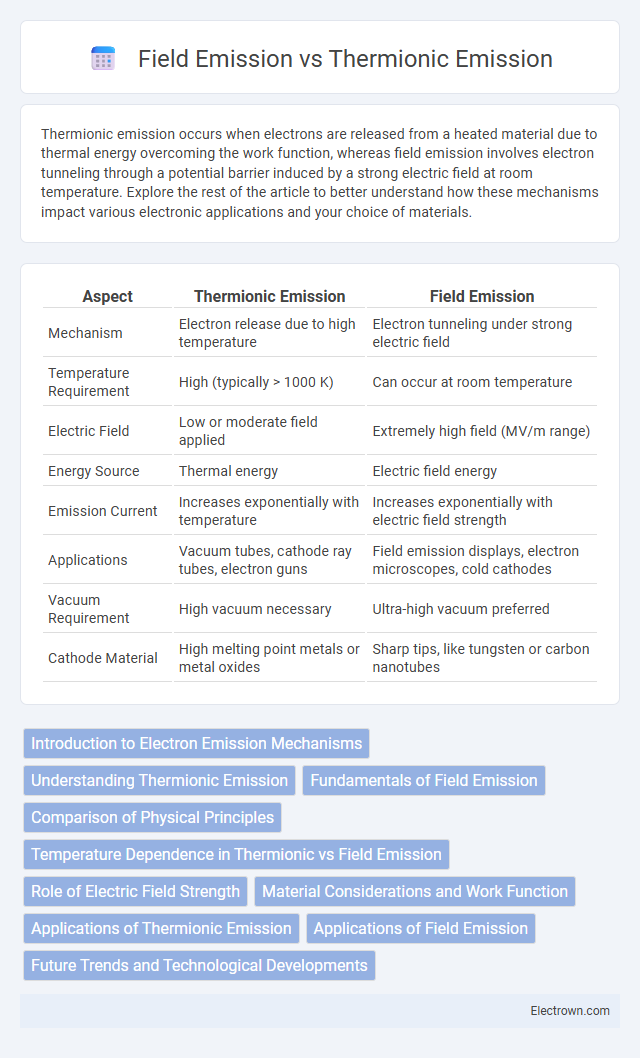Thermionic emission occurs when electrons are released from a heated material due to thermal energy overcoming the work function, whereas field emission involves electron tunneling through a potential barrier induced by a strong electric field at room temperature. Explore the rest of the article to better understand how these mechanisms impact various electronic applications and your choice of materials.
Table of Comparison
| Aspect | Thermionic Emission | Field Emission |
|---|---|---|
| Mechanism | Electron release due to high temperature | Electron tunneling under strong electric field |
| Temperature Requirement | High (typically > 1000 K) | Can occur at room temperature |
| Electric Field | Low or moderate field applied | Extremely high field (MV/m range) |
| Energy Source | Thermal energy | Electric field energy |
| Emission Current | Increases exponentially with temperature | Increases exponentially with electric field strength |
| Applications | Vacuum tubes, cathode ray tubes, electron guns | Field emission displays, electron microscopes, cold cathodes |
| Vacuum Requirement | High vacuum necessary | Ultra-high vacuum preferred |
| Cathode Material | High melting point metals or metal oxides | Sharp tips, like tungsten or carbon nanotubes |
Introduction to Electron Emission Mechanisms
Thermionic emission occurs when electrons gain sufficient thermal energy to overcome the material's work function and are emitted from the surface, commonly seen in heated cathodes. Field emission involves electron tunneling through a potential barrier under the influence of a strong electric field, enabling emission even at lower temperatures. Understanding these fundamental electron emission mechanisms is crucial for optimizing your devices in applications such as electron microscopy and vacuum electronics.
Understanding Thermionic Emission
Thermionic emission refers to the process where electrons are released from a metal surface when heated to high temperatures, overcoming the material's work function. This phenomenon is crucial in devices like vacuum tubes and cathode ray tubes, where electron flow is generated by thermal energy. The emission current density follows the Richardson-Dushman equation, highlighting the exponential dependence on temperature and the work function of the emitting material.
Fundamentals of Field Emission
Field emission involves the extraction of electrons from a material's surface due to a strong electric field, causing quantum tunneling through the surface potential barrier. This phenomenon enables electron emission at lower temperatures compared to thermionic emission, which relies on thermal energy to overcome the work function. Your understanding of field emission's fundamentals highlights its critical role in applications like electron microscopy and vacuum electronics, where cold electron sources are essential.
Comparison of Physical Principles
Thermionic emission involves electron release from a heated material, where thermal energy overcomes the work function barrier at the surface. Field emission occurs through quantum tunneling when a strong electric field reduces the surface potential barrier, allowing electrons to escape without significant heating. The key difference lies in thermionic emission relying on elevated temperature-induced energy, while field emission depends on high electric field strength to enable electron escape.
Temperature Dependence in Thermionic vs Field Emission
Thermionic emission strongly depends on temperature, with the emission current increasing exponentially as the temperature rises due to the increased thermal energy overcoming the work function of the material. In contrast, field emission primarily relies on the strength of the applied electric field and remains largely temperature-independent, as electrons tunnel through the potential barrier rather than surmounting it thermally. This fundamental difference makes thermionic emission more suitable for high-temperature applications, while field emission is effective at lower temperatures but requires intense electric fields.
Role of Electric Field Strength
Thermionic emission relies on high temperatures to overcome the material's work function, causing electrons to be emitted from the surface. Field emission depends primarily on the strength of the electric field, which lowers the potential barrier, allowing electrons to tunnel through without the need for elevated temperatures. Your choice between these methods depends on the required electric field strength and the operational conditions of the device.
Material Considerations and Work Function
Thermionic emission relies heavily on materials with low work functions, such as tungsten or cesium-coated surfaces, to efficiently emit electrons at high temperatures. Field emission, however, depends on materials with sharp tips and high electrical conductivity, like carbon nanotubes or silicon nanowires, to facilitate electron tunneling under strong electric fields regardless of temperature. Understanding the distinct material requirements and work function differences is crucial for optimizing your electron emission applications.
Applications of Thermionic Emission
Thermionic emission is widely used in vacuum tubes, cathode ray tubes, and electron microscopes due to its ability to produce a steady stream of electrons when heated. This process is fundamental in enabling devices like fluorescent lamps and radio transmitters to function efficiently. Your understanding of thermionic emission can enhance the design of electronics requiring reliable electron sources.
Applications of Field Emission
Field emission is widely utilized in electron microscopes, flat-panel displays, and vacuum electronic devices due to its ability to generate highly focused electron beams at low energy consumption. Its applications extend to high-precision electron sources for lithography and X-ray generation, benefiting from the sharp electron emission and rapid response times. These characteristics make field emission crucial in advanced nanotechnology and surface analysis tools.
Future Trends and Technological Developments
Advancements in nanomaterials and vacuum microelectronics are driving future trends in thermionic and field emission technologies, enhancing electron source efficiency and durability. Research in low-dimensional materials like graphene and carbon nanotubes is enabling field emitters with superior electron emission stability and lower power consumption. Integration of novel cathode designs with energy harvesting systems is poised to revolutionize applications in high-frequency electronics and next-generation display technologies.
Thermionic emission vs field emission Infographic

 electrown.com
electrown.com